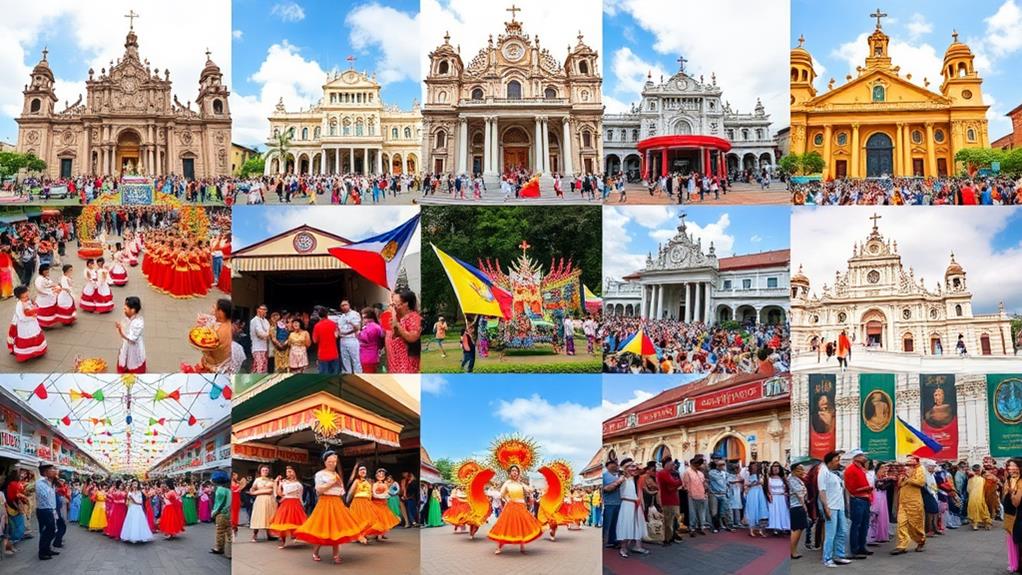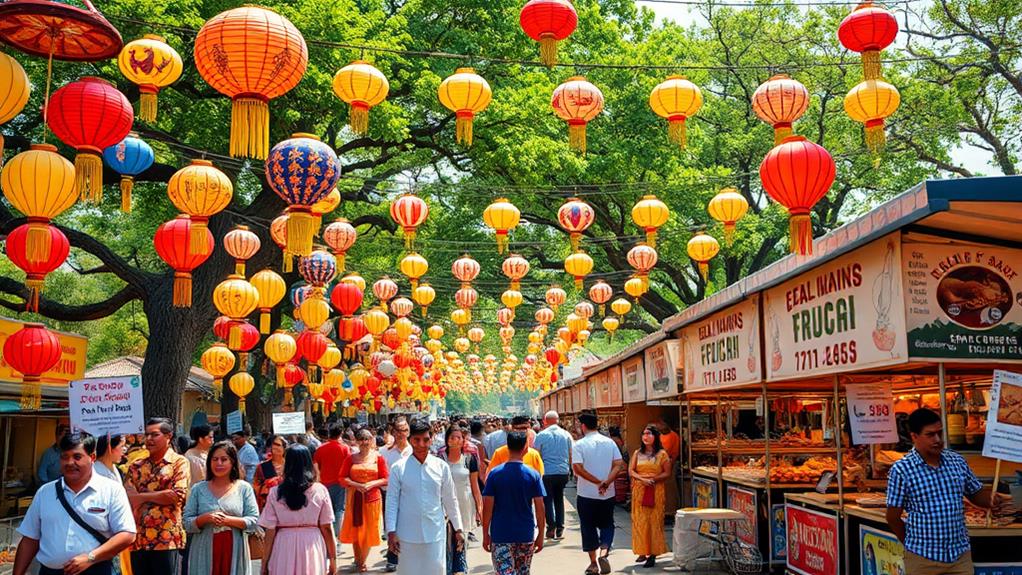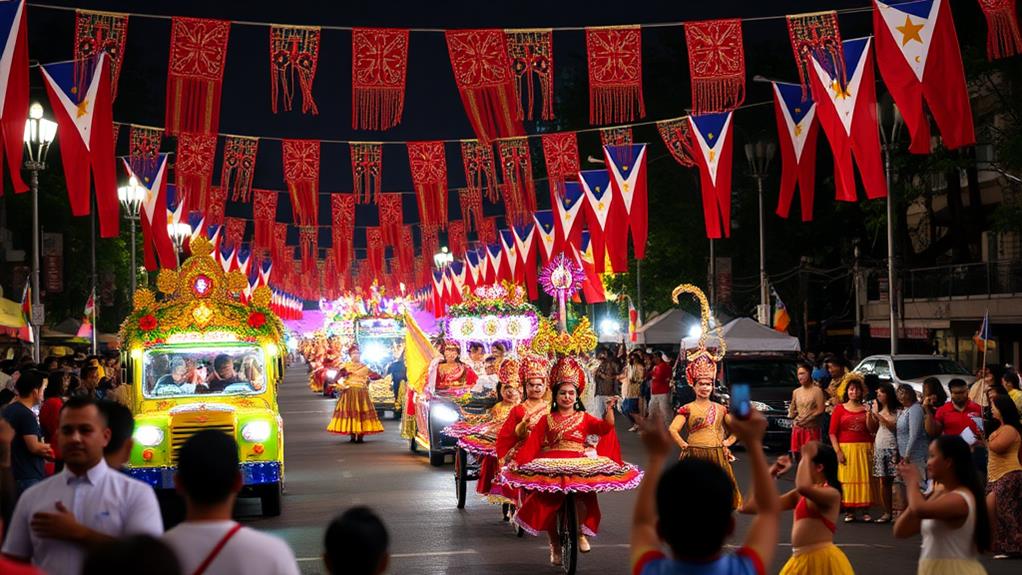The Philippines celebrates over 42,000 festivals throughout the year, showcasing its vibrant spirit and rich cultural heritage.
January's Ati-Atihan and Sinulog Festivals mark the beginning of the festive season. The Ati-Atihan Festival in Kalibo, Aklan, commemorates the arrival of Malay datus in the island of Panay, while the Sinulog Festival in Cebu City honors the Sto. Niño.
February's Panagbenga Flower Festival is another prominent celebration, featuring stunning flower floats and street dancing in Baguio City.
Other notable festivals include the Moriones Festival in March, which reenacts the Passion of Christ in Marinduque, and the MassKara Festival in October, a colorful celebration in Bacolod City.
These festivals offer unique experiences, allowing visitors to discover and appreciate Filipino traditions.
Major Festivals by Month

Filipino Festivals by Month Showcase the Country's Rich Cultural Heritage
January is a significant month for Filipino festivals, with the Ati-Atihan Festival and Sinulog Festival honoring Santo Niño through vibrant street dancing and colorful parades.
The Moriones Festival in Marinduque is a notable event in March, reenacting biblical scenes with Roman soldiers. This festival provides a glimpse into the country's history and traditions.
In February, the Panagbenga Flower Festival in Baguio City is a highlight, featuring elaborate flower floats and street dancing. This festival showcases the country's love for nature and beauty.
May is notable for the Pahiyas Festival in Lucban, where homes are decorated with local produce. This festival highlights the country's gratitude for its bountiful harvest.
October brings the MassKara Festival in Bacolod City, symbolizing resilience with colorful masks and street performances. This festival showcases the country's ability to thrive in difficult times.
These festivals offer a unique experience, with street dancing, parades, and colorful costumes that provide a deeper understanding of the Philippines' rich cultural heritage.
Cultural and Religious Observances
The Philippines is a country rich in cultural and religious observances that reflect the daily lives and values of its people. Filipino culture places a strong emphasis on family, bravery, and remembrance.
One significant example of this is the Feast of the Black Nazarene, a grand procession that honors a life-sized statue of Jesus believed to have miraculous healing powers. Millions of devotees participate in this procession, showcasing the importance of faith in Filipino culture.
Another notable observance is the Holy Week, which features various rituals and processions that reflect the passion of Christ.
The Flores de Mayo, a month-long festival dedicated to the Virgin Mary, is another example of the country's rich cultural heritage. This festival involves daily floral offerings and culminates in the Santacruzan procession.
Additionally, Araw ng Kagitingan, All Saints' Day, and All Souls' Day are also significant observances that highlight the importance of family, bravery, and remembrance in Filipino culture. These observances often involve grand processions or solemn visits to cemeteries, demonstrating the diversity and richness of Filipino culture.
Festivals Promoting Local Cuisine

Festivals in the Philippines showcase local cuisine as a vital part of the country's culture. These events go beyond grand processions and observances, highlighting the unique flavors and ingredients of each region.
The Kuyamis Festival, for instance, celebrates the country's sweet coconut products. Through food stalls and street food experiences, the festival promotes local agricultural practices and highlights the importance of coconuts in Filipino cuisine.
Other festivals, like the Pasalamat Festival, feature regional delicacies during trade exhibits. This festival promotes the rich food culture of the area, allowing visitors to sample local dishes and learn about their origins.
Some festivals focus on specific ingredients, such as the Seafoods Festival in Taguilon, Dapitan City, which highlights the local crab species, Kagang. This festival emphasizes traditional cooking methods to preserve culinary heritage and promote sustainable seafood practices.
Community participation and cultural performances play a significant role in these festivals, encouraging food exploration and reinforcing the connection between food and cultural identity.
For example, the Sunggod Ta KaManga festival offers traditional food offerings in rituals, highlighting agricultural practices and promoting local cuisine.
Festival Highlights and Celebrations
The Philippines is known for its vibrant festivals, which showcase the country's rich cultural heritage.
These festivals are a spectacle to behold, with each event featuring a kaleidoscope of colors, sounds, and movements. The Sinulog Festival in Cebu City and the Ati-Atihan Festival in Kalibo, Aklan, are two examples of Filipino festivals that bring people together with their lively street dancing and vibrant costumes.
These festivals typically feature grand parades, street dancing, and colorful costumes.
Festivals in the Philippines often celebrate the country's agricultural heritage.
The Pahiyas Festival is a celebration of the harvest season, where houses are adorned with colorful rice wafers and local agricultural produce.
Meanwhile, the Kadayawan Festival in Davao City is a week-long celebration that honors the indigenous culture and the bountiful harvest. It features street dancing, floral floats, and various cultural showcases, offering a glimpse into the country's local culture and traditions.
These festivals offer a memorable experience for both locals and visitors.
They are a testament to the Filipinos' love for celebration and community.
What are the most popular Filipino festivals and how often do they occur throughout the year?
The ranking philippine cities festivals frequency varies, but some of the most popular Filipino festivals occur annually. Among them are the Ati-Atihan Festival in January, Panagbenga Festival in February, and Sinulog Festival in January. These vibrant celebrations showcase the rich and diverse culture of the Philippines.
Cultural Significance of Festivals

Filipino Festivals: A Reflection of Rich Cultural Heritage
The Philippines is home to approximately 42,000 vibrant festivals that showcase the country's diverse cultural heritage. Attending these festivals is like experiencing a kaleidoscope of Filipino traditions and customs.
Key Aspects of Filipino Festivals
* Spiritual Devotion is a Core Aspect: Flores de Mayo and Holy Week observances are prime examples of how faith plays a significant role in Filipino culture.
Faith is an essential part of Filipino heritage, as seen in these festivals that honor the country's spiritual practices.
* Cultural Exchange and Preservation: Festivals like Ati-Atihan and Sinulog promote local heritage through music, dance, and crafts.
These festivals preserve indigenous cultures and foster pride and belonging among participants, ensuring the continuation of local traditions.
* Community Celebration is a Unifying Force: Festivals often blend indigenous and Christian traditions, showcasing vibrant street dancing and processions.
These events strengthen communal bonds and reinforce cultural identity, as seen in events honoring Santo Niño.
The Impact of Festivals on Filipino Culture and Tourism
Filipino festivals not only promote local heritage but also boost tourism, allowing for the promotion of Filipino heritage and arts on a global scale.
Visitor Experience and Travel Tips
Filipino festivals offer a vibrant and immersive experience that allows participants to engage in local celebrations. Festivals like the Sinulog and Ati-Atihan showcase rich cultural expressions through lively street dancing and colorful parades.
At these festivals, traditional Filipino cuisine is available at food stalls, offering a culinary adventure with regional flavors and local ingredients. Lechon and halo-halo are popular dishes that can be sampled during festivals.
Additionally, interactive workshops and activities provide opportunities to learn about indigenous crafts and practices, enhancing cultural understanding and appreciation.
To make the most of your festival experience:
- Time your visit around major festivals, such as the Panagbenga Flower Festival in February or the Pahiyas Festival in May.
- Book your accommodations in advance, as festivals attract large crowds and popular destinations can become busier than usual.
- Research local activities, including interactive workshops, street dancing, and local food stalls, to get the most out of your festival experience.
Questions and Answers
What Is the Top 1 Festival in the Philippines?
The top festival in the Philippines is the Sinulog Festival. It surpasses other prominent festivals in terms of popularity and cultural significance. This celebration is well-known for its vibrant street performances, elaborate costumes, and grand floats.
Why Is It Important as a Filipino to Know and Celebrate Different Philippine Festivals?
As a Filipino, it's essential to know and celebrate different Philippine festivals because they help strengthen your cultural identity. These festivals bring people together, fostering community bonding and social cohesion through various traditions, historical significance, and regional diversity.
Festivals showcase the country's festive spirit, artistic expression, culinary heritage, and family values. For instance, the Sinulog Festival in Cebu highlights the country's artistic expression through vibrant costumes, music, and street dancing. The MassKara Festival in Bacolod, on the other hand, showcases the country's festive spirit through colorful masks and lively parades.
Additionally, festivals help preserve the country's historical significance and regional diversity. The Bonok-Bonok Festival in Surigao del Sur, for example, commemorates the city's founding and showcases the region's indigenous culture. The Pista sa Nayon in Laguna, meanwhile, celebrates the region's agricultural heritage through traditional games, food, and music.
How Do Festivals in the Philippines Enrich Our Culture and Tradition?
Festivals play a vital role in enriching the cultural heritage of the Philippines.
Participating in festivals brings community bonding, as people from different backgrounds come together to celebrate. For instance, the MassKara Festival in Bacolod City showcases the city's history and culture through vibrant masks and costumes.
Festivals also preserve traditional practices, such as the Sinulog Festival in Cebu, which honors the country's patron saint, Santo Niño, through traditional dances and costumes. Artistic expression is another aspect of festivals, as seen in the Panagbenga Festival in Baguio, which features elaborate floats and street performances.
Culinary diversity is also a key feature of Philippine festivals. The Pista sa Nayon in Makati showcases traditional Filipino cuisine, such as adobo and lechon, which are an integral part of the country's cultural heritage.
Festivals also highlight the historical significance of certain events and places. The Araw ng Kagitingan in Bataan, for example, commemorates the heroism of Filipino and American forces during World War II.
Regional identity is also celebrated through festivals, such as the Kadayawan Festival in Davao, which showcases the region's rich cultural heritage and natural resources.
What Is One of the Most Significant Festivals in the Philippines and Is Held on the 9th of January as Well as on Good Friday?
The Feast of the Black Nazarene is the significant festival in the Philippines held on January 9 and Good Friday. This festival showcases the country's rich cultural heritage through spiritual practices, community bonding, and local traditions. The Feast of the Black Nazarene highlights the Philippines' strong Catholic faith, with millions of devotees participating in the procession of the Black Nazarene, a life-sized image of Jesus Christ. This festival demonstrates the country's vibrant cultural scene, where locals come together to showcase their traditions and faith.